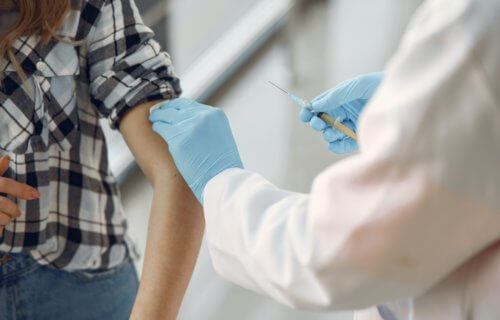SAN DIEGO, Calif. — Many expect the recent rollout of various COVID-19 vaccines to end the pandemic in short order. However, a new report finds vaccinations won’t provide a surefire guarantee of avoiding the virus. In an open letter by a group of investigators from the University of California San Diego School of Medicine and the David Geffen School of Medicine at UCLA, researchers reveal a tiny percentage of vaccinated health care workers still ended up testing positive for COVID-19.
Consequently, researchers believe safety measures must remain in place until enough people receive the vaccine and the world reaches herd immunity levels.
“Because of the compulsory daily symptom screening of health care personnel, patients, and visitors, and the high testing capacity at both UC San Diego Health and UCLA Health, we were able to identify symptomatic and asymptomatic infections among health care workers at our institutions,” says co-author Jocelyn Keehner MD, an infectious disease fellow at UC San Diego School of Medicine, in a university release.
“Moreover, we were able to describe the infection rates in a real-world scenario, where vaccine roll-out coincided with a surge of infections. We observed a low overall positivity rate among fully immunized health care workers, supporting the high protection rates of these vaccines.”
A slim chance of infection remains
Study authors looked at data from UC San Diego and UCLA health care workers receiving via either the Pfizer or Moderna vaccines between Dec. 16, 2020 and Feb. 9, 2021. In all, that dataset encompassed 36,659 first doses and 28,184 second doses.
Among all of those healthcare workers, 379 tested positive for SARS-CoV-2 at least one day after getting their shot. Seven in 10 (71%) tested positive within two weeks of their first vaccine dose. Another 37 workers tested positive after receiving their second.
As a result, researchers estimate there is still a slim chance of testing positive for COVID after getting the vaccine. Among healthcare workers at UC San Diego Health, the risk of infection after vaccination was 1.19 percent. The risk at UCLA Health was just under one percent (0.97%). Importantly, those risk profiles are higher than what both the Moderna and Pfizer clinical trials report.
“There are several possible explanations for this elevated risk,” says co-author Lucy E. Horton, MD, MPH, associate professor in the Division of Infectious Diseases and Global Public Health at UC San Diego School of Medicine and medical director of the UC San Diego Health Contact Tracing Unit.
“First, the health care workers surveyed have access to regular asymptomatic and symptomatic testing. Second, there was a regional surge in infections overlapping with vaccination campaigns during this time period. And third, there are differences in the demographics of health care workers compared to participants in the vaccine clinical trials. Health care workers tend to be younger and have a greater overall risk of exposure to SARS-CoV-2 in the community.”
Maximum immunity does not guarantee immunity
To be clear, researchers say instances of infection after vaccination are still quite rare. Specifically, they say it is most unlikely you’ll get sick 14 days after receiving a second dose. This is the typical timeframe health officials say it takes to reach “maximum immunity.”
Despite the overwhelming evidence of success, researchers conclude neither vaccine offers 100 percent guaranteed immunity.
“It underscores the critical importance of continued public health mitigation measures (masking, physical distancing, daily symptom screening and regular testing), even in highly vaccinated environments, until herd immunity is reached at large,” adds corresponding author Francesca Torriani, MD, professor of clinical medicine in the Division of Infectious Diseases and Global Public Health in the UC San Diego School of Medicine.
The study is published in the New England Journal of Medicine.
